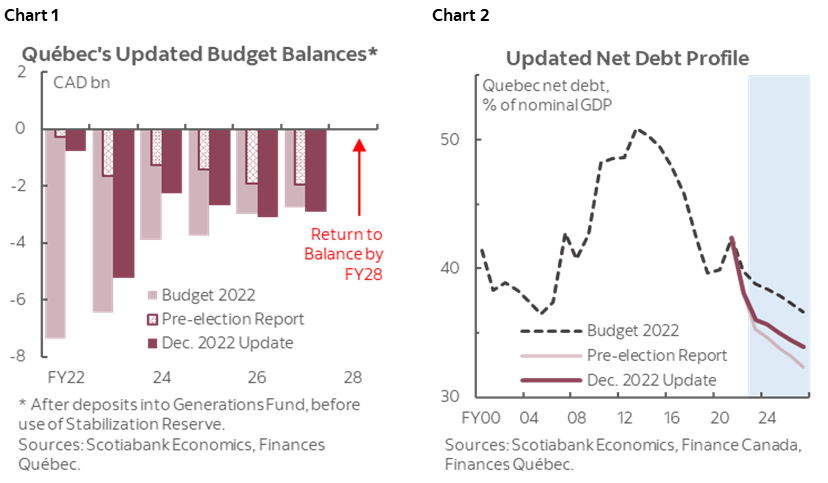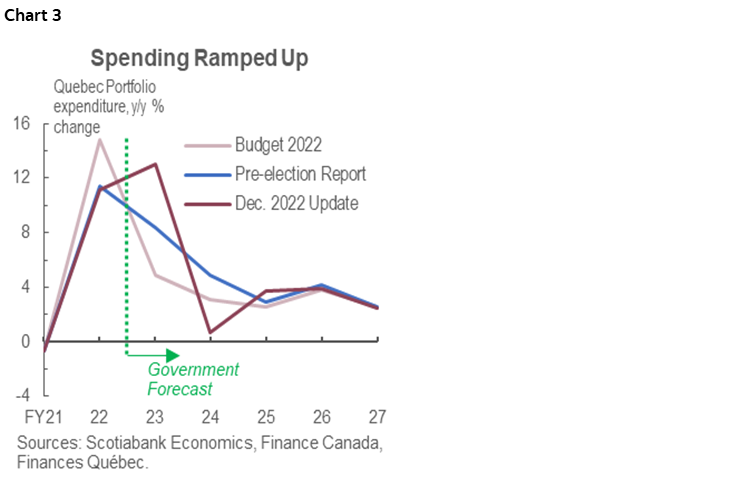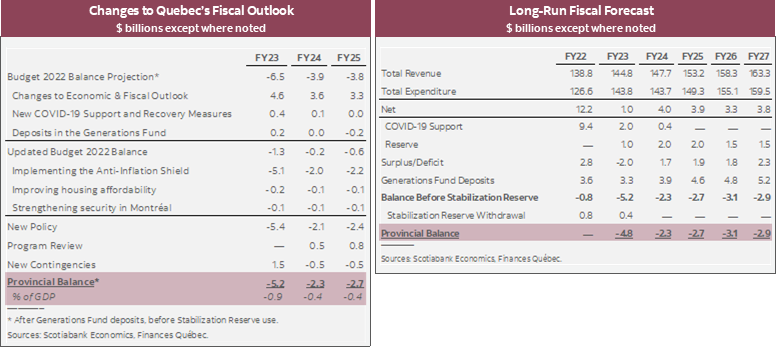SPEND NOW AND SAVE FOR THE RAINY DAYS
- Budget balance projections: -$5.2 bn (-0.9% of nominal GDP) in FY23, -$2.3 bn (-0.4% ) in FY24, and -$2.7 bn (-0.4% ) in FY25—respective anticipated improvement of $1.2 bn, $1.6 bn, and $1.1 bn versus Budget 2022 (all figures after deposits into the Generations Fund) (chart 1).
- Net debt forecasts: expected to drop to 36% of nominal GDP in FY22 and decline steadily to 33.9% by FY27—a lower trajectory than the forecast in Budget 2022 (chart 2).
- GDP expectations: 3.1% real growth and 10.0% nominal growth this calendar year—both stronger than Budget 2022 projections. Economic growth assumptions were largely revised down for 2023 to 0.7% in real terms and 2.8% in nominal terms.
- Financing program: estimated at $25.9 bn in FY23, $27.6 bn in FY24, and $32.0 bn in FY25—representing a combined FY23–25 reduction of $6 bn from March 2022 forecasts.
- New policy: $5.4 bn in FY23, $2.1 bn in FY24, and $2.4 bn in FY25—combined $13.9 bn over FY23–27 (averaged 0.5% of projected nominal GDP per year over the forecast horizon). Key measures aim to help with the near-term rising cost of living —a combination of one-time payments, a senior tax credit, and an indexation limit of government rates.
- The Update outlined improved revenues and spending profiles in the near term. The fiscal planning remained prudent and transparent to account for downside risks associated with heightened uncertainty about the economic outlook.

OUR TAKE
Quebec’s fiscal position improved modestly in the near-term relative to its forecast in Budget 2022, along with marginal downward revisions in outer years amidst a deteriorating economic outlook. The FY23–25 improvements appear less substantial than anticipated in the pre-election report in August, mainly due to new policy initiatives announced since then. Beyond FY25, longer-term structural shortfall persists at around $3 bn (-0.5% of nominal GDP), and the government reaffirmed its position of achieving balance without major spending cuts or tax increases. With a detailed plan yet to be released (likely in the next Budget), the province still aims at returning to a balanced budget by FY28 after deposits in the Generations Fund, amounting to a cumulative $37.7 bn into the Fund. Before those deposits, a surplus can be expected by FY24.
Spending ramped up in the near-term (chart 3), and increases in total expenditure should outpace revenue gains in FY23. FY23 portfolio expenditures saw a large upward revision of $5.5 bn (4.3%) with electoral promises and new policy initiatives incorporated into the plan. Debt-service costs jumped by $1.7 bn (19%), but is deemed as a one-time occurrence as it resulted from the disposal of assets from the Sinking Fund. Although the upward revision in revenues came in lower than increases in spending, the bottom line still saw a net modest improvement for FY23 due to a reduction in forecast provision, narrowing the deficit by $1.2 bn versus Budget 2022. Since the bulk of this year’s new spending is non-recurring, planned expenditure is expected to remain flat in FY24 after the 13.6% surge this fiscal year.

The Update beefed up contingencies to address significant downside risks vis-à-vis a potential recession. The baseline scenario underpinning the updated fiscal path assumes Quebec’s real growth will slow sharply to 0.7% in 2023 and then rebounds to 1.6% in 2024—both higher than the private-sector average of 0.3% and 1.3%, respectively. The Update provided an alternative scenario forecasting a recession in 2023 with Quebec’s economy contracting by -1.0% in 2023 and a slower recovery of 1.2% in 2024. The potential fiscal impact of the alternative scenario is estimated at -$1.9 bn in FY24, -$1.7 bn in FY25, and -$1.0 bn in FY26. The Update added more contingency for these years, bringing the provision amount from $1.5 bn to $2 bn each year for FY24–FY25, and maintained the $1.5 bn each year beyond FY26.
The new policy measures announced in the Update total $13.9 bn, with $5.4 bn kicking in this fiscal year and the rest evenly splitting over FY24–FY27. New policy initiatives focus on supporting households amid rising cost of living (the “Anti-Inflation Shield”, as the Update calls it), including a one-time lump sum payment announced earlier, totaling $3.5 bn (0.6% of nominal GDP) to 80% of the province’s population, which could work against tightening monetary policy on near-term inflation. A more targeted policy focuses on enhancing the senior assistance amount, bringing the maximum amount of the senior assistance tax credit from $411 to $2000. This measure has a fiscal impact of approximately $1.6 bn each year starting in FY23 and represents an on-going funding pressure
Quebec should continue to see an reduction in the province’s indebtedness, even in the alternative scenario of a recession. Quebec’s net debt is still high as a share of nominal output compared to its peers but the ratio remains on a steady downward path. The net debt-to-GDP ratio is expected to decline from 38.1% in FY22 to 36% in FY23, 2.8 ppts lower than projected in Budget 2022, before trending down gradually to 33.9% by FY27. In the alternative scenario where the economy sees a contraction in 2023, net debt could go up slightly to 36.7% of nominal GDP in FY24 before falling again to 34.8% by FY27. The province is looking to modernize its fiscal anchor in the upcoming Budget 2023,
The province’s financing program scaled back modestly for FY23, FY24 and FY25 relative to Budget 2022, estimated at $25.9 bn, $27.6 bn and $32.0 bn, respectively. As of November 17, 2022, 57% of FY23 borrowings have been completed, only 8% of which was conducted on foreign markets to limit the exposure to exchange rate volatility. The province also issued two green bonds this fiscal year under its Green Bond program, totalling $1.8 bn.

DISCLAIMER
This report has been prepared by Scotiabank Economics as a resource for the clients of Scotiabank. Opinions, estimates and projections contained herein are our own as of the date hereof and are subject to change without notice. The information and opinions contained herein have been compiled or arrived at from sources believed reliable but no representation or warranty, express or implied, is made as to their accuracy or completeness. Neither Scotiabank nor any of its officers, directors, partners, employees or affiliates accepts any liability whatsoever for any direct or consequential loss arising from any use of this report or its contents.
These reports are provided to you for informational purposes only. This report is not, and is not constructed as, an offer to sell or solicitation of any offer to buy any financial instrument, nor shall this report be construed as an opinion as to whether you should enter into any swap or trading strategy involving a swap or any other transaction. The information contained in this report is not intended to be, and does not constitute, a recommendation of a swap or trading strategy involving a swap within the meaning of U.S. Commodity Futures Trading Commission Regulation 23.434 and Appendix A thereto. This material is not intended to be individually tailored to your needs or characteristics and should not be viewed as a “call to action” or suggestion that you enter into a swap or trading strategy involving a swap or any other transaction. Scotiabank may engage in transactions in a manner inconsistent with the views discussed this report and may have positions, or be in the process of acquiring or disposing of positions, referred to in this report.
Scotiabank, its affiliates and any of their respective officers, directors and employees may from time to time take positions in currencies, act as managers, co-managers or underwriters of a public offering or act as principals or agents, deal in, own or act as market makers or advisors, brokers or commercial and/or investment bankers in relation to securities or related derivatives. As a result of these actions, Scotiabank may receive remuneration. All Scotiabank products and services are subject to the terms of applicable agreements and local regulations. Officers, directors and employees of Scotiabank and its affiliates may serve as directors of corporations.
Any securities discussed in this report may not be suitable for all investors. Scotiabank recommends that investors independently evaluate any issuer and security discussed in this report, and consult with any advisors they deem necessary prior to making any investment.
This report and all information, opinions and conclusions contained in it are protected by copyright. This information may not be reproduced without the prior express written consent of Scotiabank.
™ Trademark of The Bank of Nova Scotia. Used under license, where applicable.
Scotiabank, together with “Global Banking and Markets”, is a marketing name for the global corporate and investment banking and capital markets businesses of The Bank of Nova Scotia and certain of its affiliates in the countries where they operate, including; Scotiabank Europe plc; Scotiabank (Ireland) Designated Activity Company; Scotiabank Inverlat S.A., Institución de Banca Múltiple, Grupo Financiero Scotiabank Inverlat, Scotia Inverlat Casa de Bolsa, S.A. de C.V., Grupo Financiero Scotiabank Inverlat, Scotia Inverlat Derivados S.A. de C.V. – all members of the Scotiabank group and authorized users of the Scotiabank mark. The Bank of Nova Scotia is incorporated in Canada with limited liability and is authorised and regulated by the Office of the Superintendent of Financial Institutions Canada. The Bank of Nova Scotia is authorized by the UK Prudential Regulation Authority and is subject to regulation by the UK Financial Conduct Authority and limited regulation by the UK Prudential Regulation Authority. Details about the extent of The Bank of Nova Scotia's regulation by the UK Prudential Regulation Authority are available from us on request. Scotiabank Europe plc is authorized by the UK Prudential Regulation Authority and regulated by the UK Financial Conduct Authority and the UK Prudential Regulation Authority.
Scotiabank Inverlat, S.A., Scotia Inverlat Casa de Bolsa, S.A. de C.V, Grupo Financiero Scotiabank Inverlat, and Scotia Inverlat Derivados, S.A. de C.V., are each authorized and regulated by the Mexican financial authorities.
Not all products and services are offered in all jurisdictions. Services described are available in jurisdictions where permitted by law.

